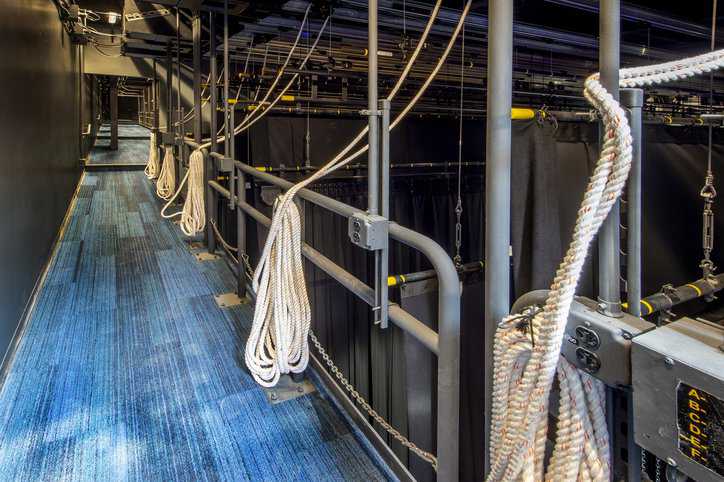A manual counterweight rigging system allows for safe and controlled movement of heavy stage elements, such as scenery, lights, curtains, and even actors “flying” up and down from the stage. This system of balanced weights and controlled movement enables the technical aspects of a theatrical production to function smoothly. ANSI E1.4-1-2022: Entertainment Technology – Manual Counterweight Rigging Systems establishes specifications for stage rigging hardware.
What Is ANSI E1.4-1?
ANSI E1.4-1-2022 covers permanently installed, manually operated counterweight systems of stage rigging hardware for raising, lowering, and suspending scenery, lighting, and similar loads. The systems illustrated in the Figures section of this standard describe common arrangements of systems used over performance areas. The American National Standard applies to rigging hardware and basic functional requirements only, not to the structure from which it is supported. ANSI E1.4-1-2022 also applies to variations of manual counterweight rigging, including rope and sandbag systems.
Through minimum performance requirements, ANSI E1.4-1-2022 establishes a basis for reasonable standards of care, safety, and for general welfare to minimize hazards associated with manual counterweight rigging systems.
While not part of this standard, building structural capacity for the intended loads shall be considered in the design and application of rigging systems.
What Is a Manual Counterweight Rigging System?
A manual counterweight rigging system is a theatrical rigging system where a load, like scenery or lighting equipment, is balanced by a set of weights on a movable carriage called a “counterweight arbor.” The counterweight arbor is loaded with weight equal to the production items hanging on the batten. By balancing the weight of stage elements with a set of counterweights, a manual counterweight rigging system enables a stage crew to easily raise and lower them with minimal effort. This system is an essential component for flexible and efficient theatrical productions—particularly when precise control movement is needed.
Objective of Manual Counterweight Rigging Systems
Manual counterweight rigging systems enable an operator to manually raise or lower the load with minimal effort. Essentially a manual counterweight rigging system uses manually operated counterweights to balance and move heavy objects on stage by hand. When balanced, almost any operator can move the line set while still maintaining control.
Batten Load Requirements in ANSI E1.4-1
Manually operated rigging adds the ability to lower and raise pipe battens by counterbalancing the load with an arbor loaded with counterweight (steel plates). ANSI E1.4-1-2022 specifies that batten design loads should be determined by a qualified person, and that batten design loads should not be less than their corresponding maximum counterbalance capacities.
Design Requirements of a Manual Counterweight Rigging System
ANSI E1.4-1-2022 details that manual counterweight rigging systems should be designed, manufactured, and installed to meet the following basic functional and safety requirements for edge protection and toe plates:
- Edge protection: The walking/working surface of loading and operating bridges should have OSHA-compliant railings and toe plates, or other OSHA-compliant edge protection.
- Toe Plates: Toe plates should extend from the walking/working surface to not less than 4″ above the surface, or not less than the maximum height at which objects are intended to be stored, whichever is greater.
ANSI E1.4-1-2022: Entertainment Technology – Manual Counterweight Rigging Systems is available on the ANSI Webstore.
